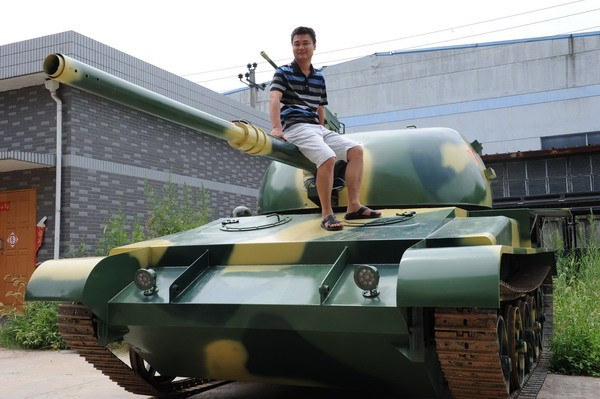Getting a 'bang' with his toy
Updated: 2011-09-27 07:51
By Xu junqian (China Daily)
|
|||||||||
|
 Hao Jinxi, owner of a factory that produces imitation trains, sits on a life-size model of a T-62 tank, his newest product, in Yuhang, Zhejiang province. [Photo/provided to China Daily]
|
YUHANG, Zhejiang - Just outside a matchbox-shaped factory sits a camouflaged giant, a life-size Soviet era T-62 tank that attracts oohs and aahs when it moves and booms.
"I made it all myself - of course with help from some other engineers in our factory," said Hao Jinxi.
"All we relied on was several photos downloaded online," boasted the 29-year-old businessman and graduate from Shanghai Railway University.
His factory, which made the tank, produces dozens of simulated trains that cater to film companies and theme parks at home and abroad.
Like millions of other Chinese, Hao has never seen a real tank before.
But his tank, at 3.2 m wide and 6.2 m long, has been as handy as a bicycle and as gratifying as a merry-go-round, offering him a ride whenever he feels depressed, frustrated, or simply bored.
The tank is well-equipped with almost everything the original model has, including a 1.15-m gun at the front.
It runs, or rather crawls, at 10 to 15 km/h, and leaves two trails of deep prints on the asphalt road.
Of course, the guns and cannons are only armed with harmless air, a mixture of oxygen and acetylene, which together blow out a cloud as if the tank is firing a salvo.
"Like many boys, I was born with a natural penchant for vehicles like race cars, jets and, ultimately, tanks. That's why I chose railway studies and imitation trains as my college major and career," he said.
For Hao, an imitation like this fulfilled a dream that he cherished for nearly three decades.
It hasn't come cheap, though.
"The process is just like inventing a tank. Before I started, all I knew was that I was building something called a tank. Sometimes, we had to remake a component 20 or 30 times, inch by inch until it finally fit," Hao recalled.
The mammoth vehicle has cost Hao 19 months and 800,000 yuan ($125,000), the price of an imitation train from his factory.
"My family doesn't understand me, but they have no choice but to support me, because that's the only way I can stop - after I'm done," said Hao.
Yet his employees and neighbors, as well as the strangers who come by, appear to love the giant as well. Every day, a number of visitors are attracted from nearby towns and cities to drive this strange vehicle.
"It's very easy to operate. Even for people who don't know how to drive a car, it takes no more than three minutes to learn," said Hao.
Wang Dapin, who used to work as an electrician in Hao's factory, now guards the big tank, and he is more than proud to show visitors every part of their "giant baby".
"It's even cool to tell others about my new job: a tank guard. How many people in the country can say that?" joked Wang.
Hao's persistence in building the tank also helped him bring new orders for his business, mostly from regular clients. A desert theme park in the Inner Mongolia autonomous region, for example, has placed an order for 30 tanks and wants them done by next year.
But Hao is not satisfied yet.
"The next step, I want to build an airplane. This time, of course, it must be a real one that can fly," said Hao with a hearty laugh.










